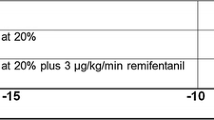Abstract
Purpose
Systemic local anesthetic (LA) toxicity resulting from inadvertent intravascular injection of LA is a rare but potentially fatal event. Early recognition of intravascular injection and approaches to improve therapeutic safety are required. This study investigated the influence of intravascular injection dose rate of bupivacaine on bupivacaine plasma levels and timing of LA-induced cardiovascular compromise.
Methods
Forty-five piglets, anesthetized with sevoflurane, were randomized into three groups. Bupivacaine was intravenously infused at a rate of 1, 4, or 16 mg/kg/min (groups A, B, and C, respectively) until mean arterial pressure (MAP) dropped to 50% of initial value. Thereafter, bupivacaine infusion was stopped and spontaneous hemodynamic course was observed. Time to MAP 50%, amount of bupivacaine infused, bupivacaine plasma level at infusion stop, spontaneous survivors, or time from bupivacaine stop to circulatory arrest were recorded.
Results
Median time to MAP 50% was 297, 119, and 65 s, respectively, in groups A, B, and C (P < 0.001). Median corresponding total amounts of bupivacaine infused were 5.0, 7.8, and 17.0 mg/kg (P < 0.01), and median bupivacaine plasma levels were 53.8, 180.0, and 439.8 μmol/l (P < 0.001). Five of 15 piglets in group A recovered spontaneously; in groups B and C, all animals died within 120 and 21 s, respectively.
Conclusion
Higher dose rates of bupivacaine showed much higher plasma bupivacaine levels related to absolute infused dose at MAP 50% and were associated with an increased mortality. Slow administration of LA is recommended to allow timely detection and stopping of inadvertent intravascular administration.




Similar content being viewed by others
References
Picard J, Meek T. Complications of regional anaesthesia. Anaesthesia. 2010;65(suppl 1):105–15.
Giaufré E, Dalens B, Gombert A. Epidemiology and morbidity of regional anesthesia in children: a one-year prospective survey of the French-language society of pediatric anesthesiologists. Anesth Analg. 1996;83:904–12.
Mauch J, Kutter APN, Madjdpour C, Koepfer N, Frotzler A, Bettschart-Wolfensberger R, Weiss M. Electrocardiographic alterations during intravascular application of three different test doses of bupivacaine and epinephrine: experimental study in neonatal pigs. Br J Anaesth. 2010;104:94–7.
Tobias JD. Caudal epidural block: a review of test dosing and recognition of systemic injection in children. Anesth Analg. 2001;93:1156–61.
Mauch J, Kutter APN, Madjdpour C, Spielmann N, Balmer C, Frotzler A, Bettschart-Wolfensberger R, Weiss M. Electrocardiographic changes during continuous intravenous application of bupivacaine in neonatal pigs. Br J Anaesth. 2010;105:437–41.
Ott K. Lipid emulsion therapy for local anaesthetic toxicity: “LipidRescue.”. Anaesthesist. 2010;59:575–86.
Mather LE, Copeland SE, Ladd LA. Acute toxicity of local anaesthetics: underlying pharmacokinetic and pharmacodynamic concepts. Reg Anesth Pain Med. 2005;30:553–66.
Lefrant JY, Coussaye JE, Ripart J, Muller L, Lalourcey L, Peray PA, Mazoit X, Sassine A, Eledjam JJ. The comparative electrophysiologic and hemodynamic effects of a large dose of ropivacaine and bupivacaine in anesthetized and ventilated piglets. Anesth Analg. 2001;93:1598–605.
Lefrant JY, Muller L, de La Coussaye JE, Lalourcey L, Ripart J, Peray PA, Mazoit X, Dauzat M, Sassine A, Eledjam JJ. Hemodynamic and cardiac electrophysiologic effects of lidocaine-bupivacaine mixture in anesthetized and ventilated piglets. Anesthesiology. 2003;98:96–103.
Palazzo MG, Kalso E, Argiras E, Madgwick R, Sear J. The uptake of bupivacaine in an in situ isolated perfused rabbit lung preparation. Pharmacol Toxicol. 1991;69:107–11.
Rotstein P, Cole JS, Pitt BR. Pulmonary extraction of (3H)bupivacaine: modification by dose, propranolol and interaction with (14C)5-hydroxytryptamine. J Pharmacol Exp Ther. 1987;240:410–4.
Scott DB. Evaluation of the toxicity of local anaesthetic agents in man. Br J Anaesth. 1975;47:56–61.
Levsky ME, Miller MA. Cardiovascular collapse from low dose bupivacaine. Can J Clin Pharmacol. 2005;12:240–5.
Marwick PC, Levin AI, Coetzee AR. Recurrence of cardiotoxicity after lipid rescue from bupivacaine-induced cardiac arrest. Anesth Analg. 2009;108:13344–6.
Smith HM, Jacob AK, Segura LG, Dilger JA, Torsher LC. Simulation education in anesthesia training: a case report of successful resuscitation of bupivacaine-induced cardiac arrest linked to recent simulation training. Anesth Analg. 2008;106:1581–4.
Cordell CL, Schubkegel T, Light TR, Ahmad F. Lipid infusion rescue for bupivacaine-induced cardiac arrest after axillary block. J Hand Surg Am. 2010;35:144–6.
Udelsmann A, Lorena SE, Girioli SU, Silva WA, Moraes AC, Andreollo NA. Hemodynamic effects of local anesthetics intoxication. Experimental study in swine with levobupivacaine and bupivacaine. Acta Cir Bras. 2008;23:55–64.
Nyström EUM, Heavner JE, Buffington CW. Blood pressure is maintained despite profound myocardial depression during acute bupivacaine overdose in pigs. Anesth Analg. 1999;88:1143–8.
Hicks SD, Salcido DD, Logue ES, Suffoletto BP, Empey PE, Poloyac SM, Miller DR, Callaway CW, Menegazzi JJ. Lipid emulsion combined with epinephrine and vasopressin does not improve survival in a swine model of bupivacaine-induced cardiac arrest. Anesthesiology. 2009;111:138–46.
Acknowledgments
The study was funded by a study grant from a donation made by UBS AG “by order of a client” and by a study grant obtained from “Stiftung für wissenschaftliche Forschung,” University of Zurich, Switzerland.
Conflict of interest
None.
Author information
Authors and Affiliations
Corresponding author
About this article
Cite this article
Mauch, J., Kutter, A.P.N., Martin Jurado, O. et al. Influence of bupivacaine injection dose rate on cardiovascular depression, subsequent hemodynamic course, and related bupivacaine plasma levels in piglets. J Anesth 25, 710–715 (2011). https://doi.org/10.1007/s00540-011-1202-8
Received:
Accepted:
Published:
Issue Date:
DOI: https://doi.org/10.1007/s00540-011-1202-8




